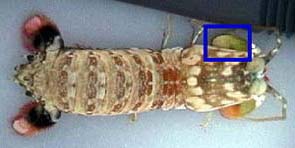The eyes have it...
Researchers have figured out some of the complexities of stomatopod vision, and have just recently demonstrated that they had polarizing filters in their eyes. What does this mean? You might be familiar with some commonly used polarizing filters—the lenses of polarized sunglasses. Often, boaters or fishermen will use polarized sunglasses to reduce glare off the water, enabling them to more easily see rocks or fish located under the water. Stomatopods have filters like these built into their eyes.
But what do stomatopods use the filters for? One day in the lab, Roy Caldwell was trying to get a photograph of a stomatopod, but there was glare off the glass of the aquarium. To cut down on the glare, he used a polarized filter on his camera. What do you think he saw?

This species of stomatopod has polarized uropods (to the left, at the tail) and antennal scales (to the right, near the eyes). Click on the blue box to find out what we can see only with a polarizing filter.
The images in the animation above were taken using a polarizing filter—we wouldn’t see the flashing red and white signals with only the naked eye. Based on his observations, Dr. Caldwell thinks that these stomatopods may use patterns visible only with polarized filters for communication.
The research team studied the question of how stomatopods use their polarizing filters during their stay on Aquarius. They observed stomatopods flashing their polarized antennal scales and uropods—signalling to animals in neighboring burrows perhaps? By examining collected animals after the mission was over Dr. Caldwell discovered other species of deep water stomatopods that have different patterns of polarization on their uropods and tail.
